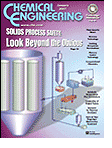Display problem ? Click HERE
Recommended :
- Subscribe FREE - Chemical Engineering
- Tips on Succession in FREE Subscription

Pressure Relief Valve Chatter is rapid reciprocating motion of the disc where the disc contacts with the seat in cyclic motion. Flutter is similar to chatter except the disc does not contact with the seat during cyclic motion.
- Subscribe FREE - Chemical Engineering
- Tips on Succession in FREE Subscription
Pressure Relief Valve Chatter is rapid reciprocating motion of the disc where the disc contacts with the seat in cyclic motion. Flutter is similar to chatter except the disc does not contact with the seat during cyclic motion.
Why Chatter is destructive ?
Chatter is destructive where it repetitive and rapid reciprocating disc knock on the valve seat may cause
i) damage to the disc & valve seat lead to leakage and passing
ii) damage to bellow lead to gas leak via bonnet vent
iii) damage to the PRV itself and interconnecting piping through vibration
iv) severe noise level
How does PSV Sound and Looks Like ?
The following video clip shows a PSV chattering due to high back pressure.
(Click to view Video Clip in Browser)
What Factor Cause PSV Chatter ?
There are at least five factors causing PSV chatter :
i) High built-up back pressure i.e Conventional PSV built-up back pressure exceeded 10% of its set pressure. Read more in "Several Impact of Backpressure on Conventional PRV"
ii) Excessive inlet pressure drop i.e pressure drop exceeded 3% of its set pressure
iii) Large PSV handling small relief flow
iv) Accelerated liquids in long inlet line knocking at pop acting PSV
v) Multiple PSVs with same pressure setting
Recommended :
- Subscribe FREE - Power Engineering (USA, Canada & Mexico)
- Subcribe FREE - Power Engineering (International)
 How to Avoid PSV Chatter ?
How to Avoid PSV Chatter ?A few ways to avoid PSV chatter are tabulated :
i) Install correct type of PSV. If conventional spring loaded PSV is installed, ensure the built-up back pressure shall always lower than 10% it set pressure. Otherwise, use balanced type.
ii) Ensure inlet line loss is below 3% of it set pressure as recommended by API. If exceeded this limit, may consider reset PSV blowdown and install pilot operated PSV with pilot sensing on protected vessel.
iii) Do not install over-designed (orifice area) PSV to handle small relieve load
iv) Install correct type PSV for liquid handling valve i.e. modulating type PSV
v) Staggered set pressure to allow chasing between PSVs.
Related Postsiii) Do not install over-designed (orifice area) PSV to handle small relieve load
iv) Install correct type PSV for liquid handling valve i.e. modulating type PSV
v) Staggered set pressure to allow chasing between PSVs.
- Back Pressure Affect Conventional PSV Set Pressure : Case Study #2 - Non-Bonnect Vent
- Back Pressure Affect Conventional PSV Set Pressure : Case Study #1 - Bonnect Vent to ATM
- How Back Pressure Affect Conventional PSV Set Pressure Subject to It Vent
- Several Impacts of Backpressure on Conventional PRV
- Use of conventional type PSV with back pressure exceeded 10% set pressure
- Relate PSV Relieving Flow to Stamped Capacity
- Thermal Relief of Non-Flashing Liquid in Pipe
- Simple Flow Chart to Determine Requirement of Thermal Relief
- Useful Documents Related to Pressure Relief Valve (PRV) - Part 3
- Useful Documents Related to Pressure Relief Valve (PRV) - Part 2
- Useful Documents Related to Pressure Relief Valve (PRV) - Part 1
Pressure vessel engineering Canada & US
ReplyDeleteJM Engineering provides Services of
Pressure vessel design Canada Us ,Pressure vessel design Canada & Us,Pressure vessel drawings Canada & US ,
Heat exchanger design Canada & US,
Heat exchanger drawings Canada & US , Piping design Canada & US.